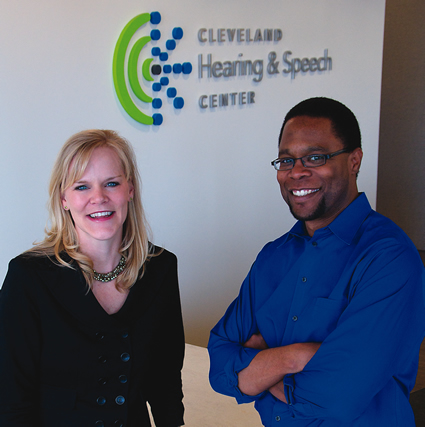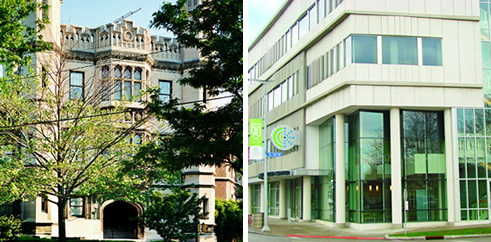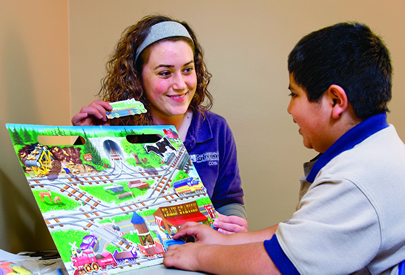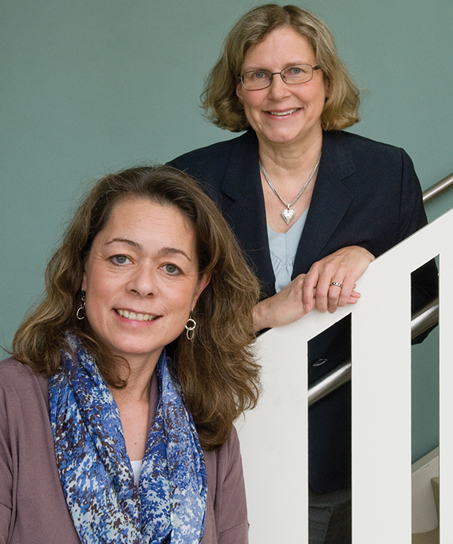In the College of Arts and Sciences, faculty members from different departments often come together to conduct research or to teach interdisciplinary classes. But this year, the faculty in psychology and communication sciences (COSI) took a further step. They decided that the best way to promote collaboration, expand into new research areas and enrich their course offerings was to merge their two departments into a single entity. As a result, the college is now home to a new Department of Psychological Sciences.
"We felt that we would be able to develop exciting, distinctive opportunities for students and faculty in both areas if we combined forces," explains Lee Thompson, professor of psychology and chair of the new department. "I think of it as a merging of strengths."
At the Intersection
All of the programs once housed in psychology and communication sciences will be continued by the new department. These include COSI's undergraduate minor in health communications and its master's program in speech-language pathology. At the same time, many of the department's offerings will be enhanced. For example, COSI's doctoral program will now include shared courses with graduate programs in clinical and experimental psychology.

"Students in the newly merged department will experience expanded clinical experiences and research opportunities," says Barbara Lewis, professor of communication sciences and adjunct professor of pediatrics at the CWRU School of Medicine. "By eliminating duplicated classes, we will also be able to offer new, specialized seminars, and we can develop courses that will be co-taught by faculty with expertise in each area."
Even before the merger, some students pursued double majors in psychology and communication sciences. One such student, Alison Pavlik '10, completed her bachelor's degree last May and has stayed for an additional year to earn an MA in speech-language pathology.
In the new department, Thompson expects more psychology majors to follow Pavlik's example. The master's program is attractive to students who want to work in the health professions but are not interested in going to medical school. And whether they go on to careers as speech-language therapists or as researchers, their psychology background will be immensely valuable.
"One of the puzzles of speech and language problems is that they often co-occur with behavioral and learning problems," Thompson explains. "Trying to detect where one ends and the other begins is our current challenge. This work is very much at the intersection of developmental psychology and communication sciences."
Collaboration by Design
Research collaborations between faculty members in the two disciplines are nothing new. Thompson and Lewis, for example, have studied twins to determine the extent to which skills associated with early literacy are inherited. But until now, such collaborations have occurred more by chance than by design.
The merger will change that. The department is launching a colloquium series in which faculty members from psychology and communication sciences will present their work and get to know one another. Collectively, the faculty will target research opportunities in areas of common interest.
The previous divide between psychology and communication sciences was symbolized by the separate sites of the two departments. Psychology was housed entirely in the Mather Memorial Building on the CWRU campus, while communication sciences is located in the Cleveland Hearing & Speech Center (CHSC), where faculty members and students engage in research and clinical activities with center staff and clients.
Itself the product of a merger—the old Cleveland Hearing Center joined the Speech Center of what was then Western Reserve University in 1945—CHSC is now home not only to COSI offices and laboratories, but also to several psychology labs. In addition, the training clinic for the graduate program in clinical psychology has moved from Mather Memorial to expanded, professional quarters at CHSC.
"Now, the two departments share not only a name but also a physical space. The proximity makes collaboration even more likely," says COSI assistant professor Jennell Vick, who studies the effects of traumatic brain injury and conditions such as cerebral palsy on speech production in children. Vick earned a master's degree from Case Western Reserve before going on to complete her doctorate at the University of Washington. The merger was one of the reasons she decided to return to CWRU as a faculty member.
The new department puts COSI faculty in a stronger position to pursue grant opportunities, Vick says. Major funders, including the National Science Foundation and the National Institutes of Health, place a high premium on interdisciplinary research—and the new department is, by definition, interdisciplinary.
Faculty members also emphasize the advances in knowledge that they can achieve through collaboration. "The merger means that we can have fresh eyes looking at problems in ways different from those in which we are trained," says T. J. McCallum, associate professor of psychology. "It's a case of combining my input of 'A-B-C' with their input of 'X-Y-Z' to develop a new level of basic knowledge and experience with which to address a given problem."

Cleveland Hearing & Speech Center Photo Courtesy of Cleveland Hearing & Speech Center
McCallum operates a lab called "The Brain Emporium," where he and his students research the efficacy of computerized cognitive-enhancement programs for older adults. While the psychology faculty has a strong reputation in areas related to children and youth, McCallum is helping propel its expansion into issues of aging and illness. Some of his research, for example, focuses on "cognitive slippage"—attention and memory loss associated with strokes or cancer therapy.
Recently, McCallum moved his lab to CHSC. Now, communication sciences students interested in aphasia can observe visitors to the Brain Emporium as part of their clinical experience. In addition, the lab is now available to participants in CHSC's "Speak Easy" program, a conversation group for stroke patients and other people with neurologically based communication disorders.

Although brand-new, the Department of Psychological Sciences is already generating interest beyond Case Western Reserve.
"In the short time since the merger, we have attracted more applicants to our graduate programs and a stronger pool of applicants for faculty positions," says Lewis. "And the response from other universities with communication sciences programs has been extraordinarily positive, with several of my colleagues remarking that they would like to see something similar happen at their schools."
And what is the next step in the department's evolution?
"We are in the middle of a faculty search right now, looking for a person who can bridge both psychology and communication sciences in teaching and research," says Thompson. "We have had a huge number of applications, and many of the applicants said the same thing: 'I wasn't on the job market, but I want to be in this new department.' So I think it's safe to say that we're on the right track."
Mark Gottlieb is a freelance writer.





